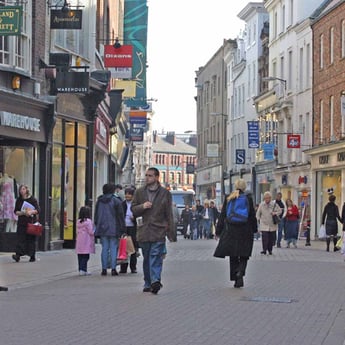Weathering the retail storm: how we can build resilient town centres

Following the publication of Bill Grimsey’s timely second review and the announcement of a new government-backed review of high streets to be launched, the continued challenges faced by town centres remains a high priority in the public eye.
The fact that town centres can no longer survive as purely shopping locations is not a new or contentious observation. Retail brands that have long been high street anchors are closing stores, units are sitting vacant, and the uncertainty within the sector continues.
However, town centres remain important as places of interaction, and in the midst of what seems a frenzy of research and recommendations relating to their future, we must take a moment to reflect and remind ourselves to understand and define the functional role of a town centre, allowing this to shape its offer.
Town centre strategies must promote well thought out mixed-use development to regain footfall and activity in town centres as well as provide community facilities at their heart. The mix of uses should reflect and support a town centre’s functional role, but how can this be defined? This question is often overlooked, but without taking it seriously it is near impossible to deliver a successful mix that reflects local identity and character, and creates a destination that people want to dwell. It also puts us at risk of trying to force ‘best practice’ examples into contexts where they do not fit. Instead, we should be answering this question by focusing on the town centre audience.
We need to better understand what role the town centre is providing and should provide going forward by asking who is currently using the town centre, as well as why, how and when. This should consider local residents, workers and visitors. We can strengthen the existing anchors that continue to be successful, diversify the offer to provide a range of new opportunities to increase the time people spend in the town centre and the number of people who visit, and reflect the gaps in local provision the town centre may be able to fill.
We also need to consider how the audience could evolve in the future and what we can do to support this, acknowledging that a diverse audience in terms of demographic and socio-economic characteristics can drive the demand for a more diverse mix of uses, and therefore a more successful and vibrant town centre.
Residential development can introduce a new and diverse audience to complement existing footfall. Residents will require a range of community facilities and services in the town centre and will provide the footfall and demand to support a greater mix of retail, leisure and food & beverage uses. A mixed and balanced residential community can be supported by providing varying types and tenures of housing, exploring opportunities across a range of residential models including student housing, assisted living, PRS and co-living. Residential development will also create value that supports the delivery of commercial and community uses, overcoming viability challenges in certain contexts.
Equally, employment activity should be encouraged to locate in town centres, particularly when it supports a shift from a consumptive to a productive town centre economy. This can be accommodated through the provision of new, refurbished or repurposed workspace that support a flexible mix of activity. With the increasing competition for businesses to attract and retain the best talent, the town centre can prove a particularly attractive location for employees considering public transport connectivity and access to services and amenities. Employees are an important part of the audience profile and drive demand for leisure and food & beverage uses beyond that generated solely by residents.
This will play out very differently in different contexts, but can lead to an appropriate and locally reflective offer for town centres across a range of scales and market dynamics. Not all town centres can become a major tourist destination, or attract a cluster of creatives and independents. However, they can all find and celebrate an authentic role and purpose that meets the needs of the local community. This will help them weather the current retail storm and redefine themselves as desirable places to live, work and play.
Laura is a Senior Consultant in GVA’s Planning Development & Regeneration team, working on a number of town centre masterplans and strategies for economic growth and regeneration.
